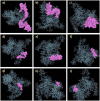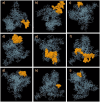Design of multivalent-epitope vaccine models directed toward the world's population against HIV-Gag polyprotein: Reverse vaccinology and immunoinformatics
- PMID: 39331650
- PMCID: PMC11432917
- DOI: 10.1371/journal.pone.0306559
Design of multivalent-epitope vaccine models directed toward the world's population against HIV-Gag polyprotein: Reverse vaccinology and immunoinformatics
Abstract
Significant progress has been made in HIV-1 research; however, researchers have not yet achieved the objective of eradicating HIV-1 infection. Accordingly, in this study, eucaryotic and procaryotic in silico vaccines were developed for HIV-Gag polyproteins from 100 major HIV subtypes and CRFs using immunoinformatic techniques to simulate immune responses in mice and humans. The epitopes located in the conserved domains of the Gag polyprotein were evaluated for allergenicity, antigenicity, immunogenicity, toxicity, homology, topology, and IFN-γ induction. Adjuvants, linkers, CTLs, HTLs, and BCL epitopes were incorporated into the vaccine models. Strong binding affinities were detected between HLA/MHC alleles, TLR-2, TLR-3, TLR-4, TLR-7, and TLR-9, and vaccine models. Immunological simulation showed that innate and adaptive immune cells elicited active and consistent responses. The human vaccine model was matched with approximately 93.91% of the human population. The strong binding of the vaccine to MHC/HLA and TLR molecules was confirmed through molecular dynamic stimulation. Codon optimization ensured the successful translation of the designed constructs into human cells and E. coli hosts. We believe that the HIV-1 Gag vaccine formulated in our research can reduce the challenges faced in developing an HIV-1 vaccine. Nevertheless, experimental verification is necessary to confirm the effectiveness of these vaccines in these models.
Copyright: © 2024 Hashempour et al. This is an open access article distributed under the terms of the Creative Commons Attribution License, which permits unrestricted use, distribution, and reproduction in any medium, provided the original author and source are credited.
Conflict of interest statement
The authors have declared that no competing interests exist.
Figures









Similar articles
-
Immunoinformatics design of a novel epitope-based vaccine candidate against dengue virus.Sci Rep. 2021 Oct 5;11(1):19707. doi: 10.1038/s41598-021-99227-7. Sci Rep. 2021. PMID: 34611250 Free PMC article.
-
Reverse vaccinology approaches to design a potent multiepitope vaccine against the HIV whole genome: immunoinformatic, bioinformatics, and molecular dynamics approaches.BMC Infect Dis. 2024 Aug 28;24(1):873. doi: 10.1186/s12879-024-09775-2. BMC Infect Dis. 2024. PMID: 39198721 Free PMC article.
-
Exploring T & B-cell epitopes and designing multi-epitope subunit vaccine targeting integration step of HIV-1 lifecycle using immunoinformatics approach.Microb Pathog. 2019 Dec;137:103791. doi: 10.1016/j.micpath.2019.103791. Epub 2019 Oct 10. Microb Pathog. 2019. PMID: 31606417
-
Multiple Approaches for Increasing the Immunogenicity of an Epitope-Based Anti-HIV Vaccine.AIDS Res Hum Retroviruses. 2015 Nov;31(11):1077-88. doi: 10.1089/AID.2015.0101. Epub 2015 Aug 13. AIDS Res Hum Retroviruses. 2015. PMID: 26149745 Review.
-
Recombinant Salmonella enterica serovar Typhimurium as a vaccine vector for HIV-1 Gag.Viruses. 2013 Aug 28;5(9):2062-78. doi: 10.3390/v5092062. Viruses. 2013. PMID: 23989890 Free PMC article. Review.
Cited by
-
Evaluating HIV drug resistance in the middle East and North Africa and its associated factors: a systematic review.Virol J. 2025 Apr 22;22(1):112. doi: 10.1186/s12985-025-02740-8. Virol J. 2025. PMID: 40264168 Free PMC article.
-
An integrated mutation-based immunoinformatic approach incorporating variability in epitopes: a study based on HIV subtype C.Front Immunol. 2025 May 20;16:1540253. doi: 10.3389/fimmu.2025.1540253. eCollection 2025. Front Immunol. 2025. PMID: 40463364 Free PMC article.
-
Exploratory algorithms to devise multi-epitope subunit vaccine by examining HIV-1 envelope glycoprotein: An immunoinformatics and viroinformatics approach.PLoS One. 2025 Feb 27;20(2):e0318523. doi: 10.1371/journal.pone.0318523. eCollection 2025. PLoS One. 2025. Retraction in: PLoS One. 2025 May 6;20(5):e0324076. doi: 10.1371/journal.pone.0324076. PMID: 40014623 Free PMC article. Retracted.
-
High resolution class I HLA-A, -B, and -C diversity in Eastern and Southern African populations.Sci Rep. 2025 Jul 2;15(1):23667. doi: 10.1038/s41598-025-06704-4. Sci Rep. 2025. PMID: 40603473 Free PMC article.
-
Integrated Immuno and bioinformatics assisted novel epitope vaccine against HIV infection: a study based on complete genome.Virol J. 2025 Jul 9;22(1):228. doi: 10.1186/s12985-025-02764-0. Virol J. 2025. PMID: 40634976 Free PMC article.
References
-
- Dehghani B, Hasanshahi Z, Hashempour T, Kazerooni PA (2021) Subtype classification by polymerase and gag genes of HIV-1 Iranian sequences registered in the NCBI GenBank. Current Proteomics 18: 153–161.
-
- Halaji M, Hashempour T, Moayedi J, Pouladfar GR, Khansarinejad B, et al.. (2019) Viral etiology of acute respiratory infections in children in Southern Iran. Revista da Sociedade Brasileira de Medicina Tropical 52. - PubMed
-
- Hashempoor T, Alborzi AM, Moayedi J, Ajorloo M, Bamdad T, et al.. (2018) A decline in anti-core+ 1 antibody titer occurs in successful treatment of patients infected with hepatitis C virus. Jundishapur Journal of Microbiology 11.
-
- Fani M, Sadooni R, Nejad MH, Mirzavieh NN, Mobarak S, et al.. (2023) Two Oncoviruses of HPV and EBV in Breast Cancer: An Iran-based Study. Journal of Liaquat University of Medical & Health Sciences 22: 169–173.
MeSH terms
Substances
LinkOut - more resources
Full Text Sources
Research Materials

